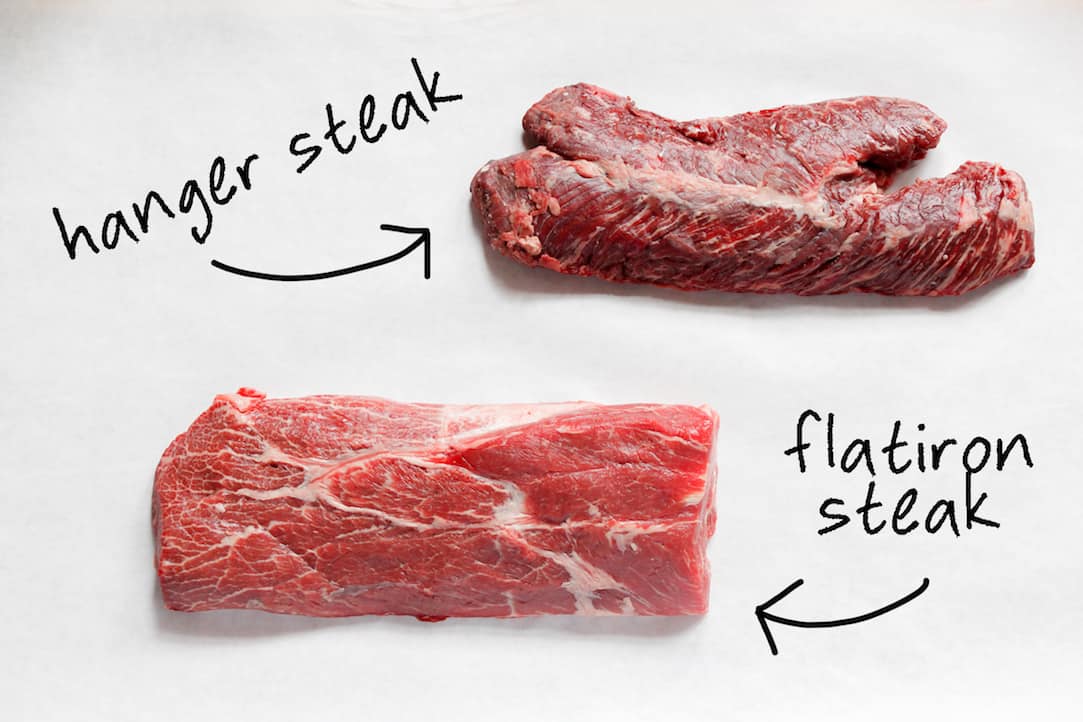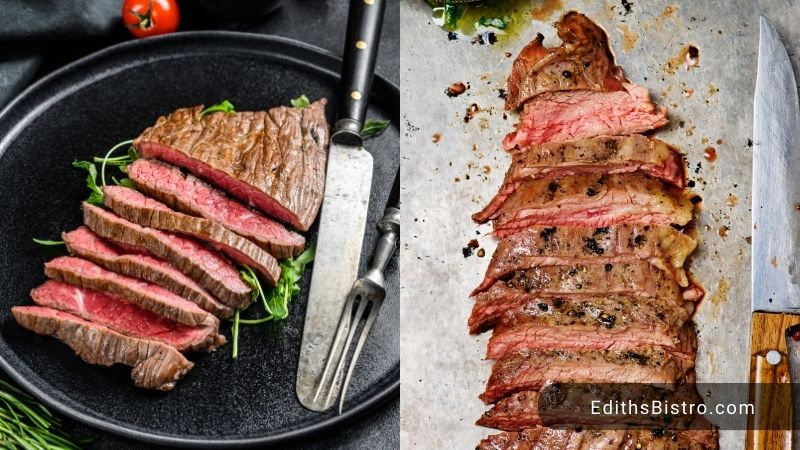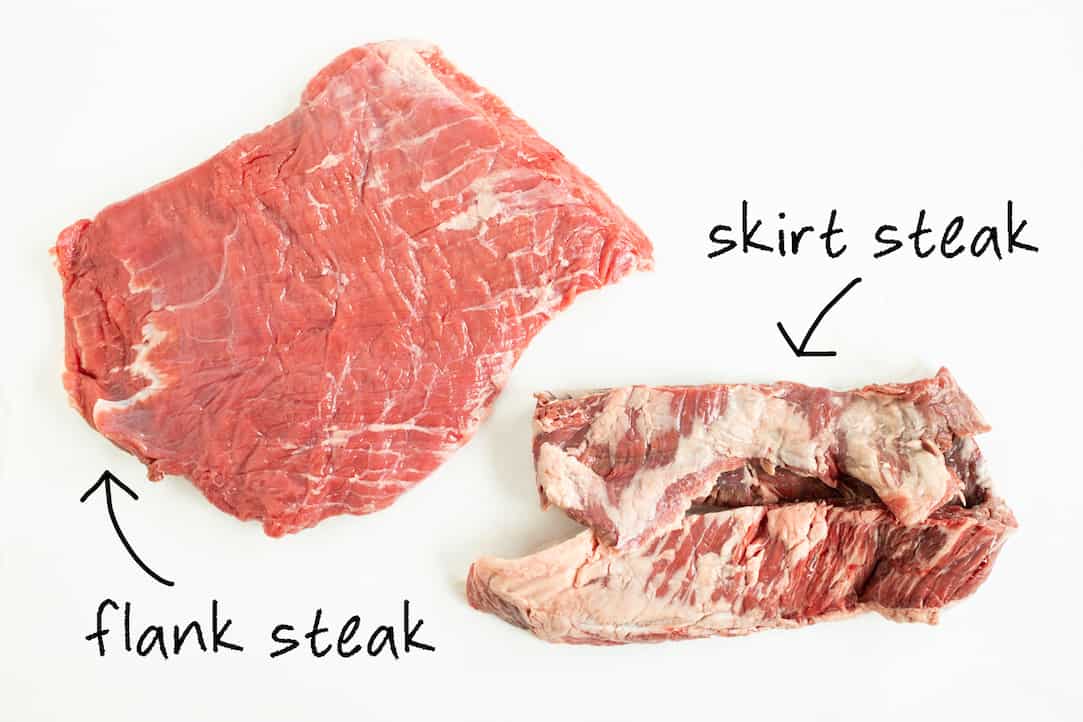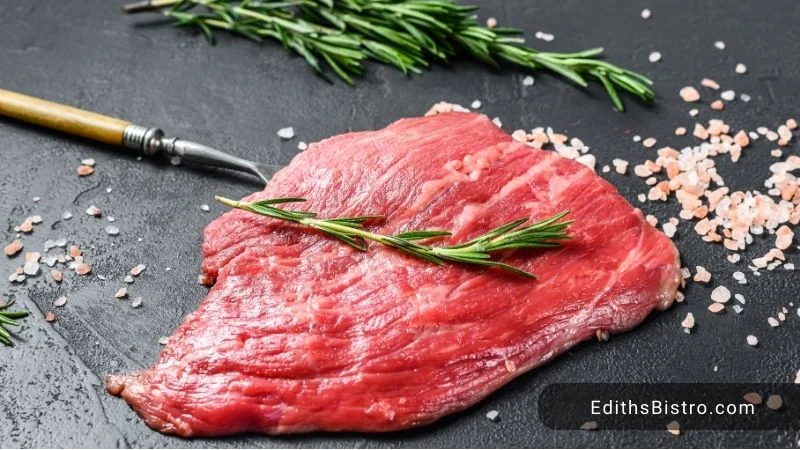Flank Steak

Flank steak is a cut of beef that is known for its bold flavor and lean texture. It is derived from the abdominal muscles of the cow, specifically from the primal flank. While flank steak is a tougher cut, it can be made tender and juicy with the right cooking techniques, such as marinating and slicing against the grain. This versatile cut of meat is commonly used in dishes like fajitas, stir-fries, and steak salads. Flank steak is also great for grilling or pan-searing to achieve a delicious caramelized exterior and a medium-rare or medium doneness. Serve it with your favorite side dishes and enjoy a flavorful and satisfying meal.
1 Flank Steak
Flank steak is a popular cut of beef known for its bold flavor and lean texture. It is derived from the lower abdominal region of the cow, near the belly. Despite being a tougher cut, flank steak can be made tender and juicy through proper cooking techniques, such as marinating and slicing against the grain. It is commonly used in dishes like fajitas, stir-fries, and steak salads. Flank steak is also great for grilling or pan-searing to achieve a delicious caramelized exterior and a medium-rare or medium doneness.
Cut, Texture, And Flavor
The flat iron steak is derived from the chuck or shoulder area of the cow, specifically the top blade muscle. It is known for its rectangular or flat shape. This cut offers a tender and juicy texture, making it a popular choice among steak lovers. Its flavor is rich and intense, with a pronounced beefy taste. On the other hand, flank steak comes from the lower abdominal region of the cow, near the belly. It has a lean and fibrous texture, which can be made tender and succulent through proper cooking techniques. Flank steak has a bold and robust flavor that is slightly milder compared to the flat iron steak.
2 Flank Steak

Best Cooking Methods
When it comes to cooking flank steak, it is important to use the right techniques to maximize tenderness and flavor. Here are some popular methods:
- Grilling: Flank steak is excellent for grilling due to its lean and meaty texture. Cook it quickly over high heat to medium-rare or medium doneness for the best results.
- Broiling: Preheat your broiler and place the steak on a broiler pan. Cook for a few minutes on each side, keeping a close eye to prevent overcooking.
- Stir-Frying: Cut the flank steak against the grain into thin strips and stir-fry it with your favorite vegetables and sauces. This method is quick and produces a delicious, Asian-inspired dish.
- Braising: For extra tenderness, braise flank steak by slow-cooking it in liquid for a long period. This method is ideal for turning tougher cuts of meat into a melt-in-your-mouth sensation.
Remember to let the flank steak rest after cooking and slice it thinly against the grain to maximize tenderness and reduce chewiness. Enjoy your flavorful flank steak in various dishes, from fajitas to stir-fries!
Best Cooking Methods
Best Cooking Methods: Flank steak is excellent for grilling due to its lean and meaty texture. Cook it quickly over high heat to medium-rare or medium doneness. It can also be broiled for a few minutes on each side or stir-fried with vegetables. Braising is another method for extra tenderness.
Flat Iron Steak
Flat Iron Steak is a flavorful and tender cut of meat that is known for its marbling. It comes from the shoulder of the cow and is considered one of the best cuts for grilling or pan-searing. Flat Iron Steak is versatile and pairs well with a variety of seasonings and sauces, making it a popular choice for steak lovers.
1 Flat Iron Steak

Flat Iron Steak is a flavorful and tender cut of meat that is known for its marbling. It comes from the shoulder of the cow and is considered one of the best cuts for grilling or pan-searing. Flat Iron Steak is versatile and pairs well with a variety of seasonings and sauces, making it a popular choice for steak lovers.
Overview And Preparation
Flat Iron Steak is a flavorful and tender cut of meat that is known for its marbling. It comes from the shoulder of the cow and is considered one of the best cuts for grilling or pan-searing. Flat Iron Steak is versatile and pairs well with a variety of seasonings and sauces, making it a popular choice for steak lovers.
2 Flat Iron Steak
Tenderness and Juiciness
Flat Iron Steak is known for its exceptional tenderness and juiciness. It has a rich marbling of fat that contributes to its moistness and flavor. This cut is considered one of the most tender and tasty steaks, similar to a ribeye or filet mignon. Its tenderness makes it a versatile option for various cooking methods, including grilling, broiling, or pan-searing. The juiciness of the Flat Iron Steak enhances the overall eating experience, ensuring a flavorful and enjoyable meal.
Tenderness And Juiciness

Flat Iron Steak is known for its exceptional tenderness and juiciness. It has a rich marbling of fat that contributes to its moistness and flavor. This cut is considered one of the most tender and tasty steaks, similar to a ribeye or filet mignon. Its tenderness makes it a versatile option for various cooking methods, including grilling, broiling, or pan-searing. The juiciness of the Flat Iron Steak enhances the overall eating experience, ensuring a flavorful and enjoyable meal.
Flank Vs Flat Iron Steak
Flank and Flat Iron Steak are two contrasting beef cuts with distinct characteristics. Flank steak is known for its toughness and requires marinating to enhance tenderness. On the other hand, Flat Iron Steak is more tender and flavorful, thanks to its marbling. The choice between the two depends on personal preference and intended culinary use.
Nutritional Value Comparison
When comparing the nutritional value of flank steak and flat iron steak, there are some notable differences. Flank steak tends to be leaner, with less fat content and fewer calories. On the other hand, flat iron steak contains more marbling, resulting in a higher fat content and richer flavor. It’s important to consider personal dietary needs and preferences when choosing between the two cuts.
1 Flank Vs Flat Iron Steak

Flank steak and flat iron steak are two distinct cuts of beef with varying characteristics. Flank steak is a leaner cut that comes from the abdominal muscles of the cow, while flat iron steak is obtained from the shoulder area, specifically the top blade muscle. The differences in texture, flavor, and cooking methods make them suitable for different culinary applications.
Protein And Fat Content
When comparing the protein and fat content of flank steak and flat iron steak, there are slight differences. Flank steak contains approximately 21.2 grams of protein and 8.29 grams of total fat per serving. On the other hand, flat iron steak has slightly less protein at 18.8 grams but slightly more total fat at 11.3 grams per serving. These variations in protein and fat content contribute to the different textures and flavors of each cut.
2 Flank Vs Flat Iron Steak
Vitamin and Mineral Differences
When comparing the vitamin and mineral content of flank steak and flat iron steak, there are slight variations. Flank steak contains slightly higher amounts of vitamin B12, iron, and zinc compared to flat iron steak. However, flat iron steak contains slightly higher amounts of vitamin A and vitamin C. Both cuts of steak provide important nutrients, but the specific levels vary slightly.
Vitamin And Mineral Differences

When comparing the vitamin and mineral content of flank steak and flat iron steak, there are slight variations. Flank steak contains slightly higher amounts of vitamin B12, iron, and zinc compared to flat iron steak. However, flat iron steak contains slightly higher amounts of vitamin A and vitamin C. Both cuts of steak provide important nutrients, but the specific levels vary slightly.
Flank Vs Flat Iron Steak
When comparing flank steak and flat iron steak, there are notable differences in flavor and tenderness. Flank steak has a beefier taste and is known for being tougher, requiring a marinade for tenderness. On the other hand, flat iron steak is more flavorful and tender, thanks to its marbling. Both cuts have their own unique qualities that cater to different culinary preferences and cooking techniques.
Cooking Techniques
When it comes to cooking techniques for flank and flat iron steak, grilling and pan-searing are popular options. Flank steak benefits from being marinated before grilling to enhance tenderness and flavor. Flat iron steak can also be grilled, but it is often pan-seared to create a delicious crust. Both cuts can be cooked to a delicious medium-rare to medium doneness for optimal juiciness and tenderness.
1 Flank Vs Flat Iron Steak

Flank and flat iron steak are two different cuts of beef. Flank steak is a leaner cut that comes from the abdominal muscles of the cow, while flat iron steak comes from the shoulder area, specifically the top shoulder blade. These cuts differ in flavor, texture, and cooking methods, making them suitable for different culinary applications.
Grilling Vs Pan-searing
When it comes to cooking flank and flat iron steak, there are two popular methods: grilling and pan-searing. Grilling is a great option for both cuts, as it allows for the natural flavors to enhance and gives the meat a smoky taste. On the other hand, pan-searing is a quick and convenient method that results in a delicious crust on the steak. The choice between grilling and pan-searing depends on personal preference and the equipment available.
2 Flank Vs Flat Iron Steak
When comparing flank and flat iron steak, it’s important to note that flat iron steak is known for its tenderness and marbling, resulting in a more flavorful experience. On the other hand, flank steak is leaner but requires marinating to achieve desired tenderness. The choice between the two depends on personal preference for tenderness and flavor.
Marinating And Seasoning Tips

When it comes to marinating and seasoning flank and flat iron steak, there are a few tips to keep in mind. For flank steak, marinating is essential to tenderize the meat. Opt for marinades that include ingredients like soy sauce, citrus juices, and vinegar to help break down the tough fibers. On the other hand, flat iron steak benefits from a simple seasoning of salt, pepper, and a few additional herbs and spices for added flavor. Avoid over-marinating flat iron steak, as it can cause the meat to become mushy. Whether marinating or seasoning, always let the steak sit at room temperature for about 30 minutes before cooking to ensure even cooking and a flavorful result.
Flank Vs Flat Iron Steak
Flank steak and flat iron steak are both popular cuts of beef that offer distinct flavors and textures. Flank steak is known for its toughness and requires marinating to tenderize the meat, while flat iron steak is more tender and flavorful. When it comes to cooking techniques, flank steak is best suited for grilling, while flat iron steak can be pan-seared or grilled. Overall, the choice between flank and flat iron steak depends on personal preference and the desired cooking method.
Serving Suggestions
When it comes to serving flank and flat iron steak, there are plenty of delicious options. For flank steak, it pairs well with chimichurri sauce, roasted vegetables, or on top of a salad. Flat iron steak is delicious with a side of mashed potatoes, roasted asparagus, or alongside grilled vegetables. Get creative with your sides to enhance the flavors of these mouthwatering steaks.
1 Flank Vs Flat Iron Steak

When comparing flank and flat iron steak, there are noticeable differences in their characteristics and taste. Flank steak is leaner and comes from the abdominal muscles, while flat iron steak is more marbled and comes from the shoulder area. They also differ in tenderness and cooking methods.
Side Dishes Pairings
When it comes to side dishes, both flank steak and flat iron steak can be complemented by a variety of options. For flank steak, popular side dishes include roasted vegetables, garlic mashed potatoes, or a fresh green salad. On the other hand, flat iron steak pairs well with grilled asparagus, roasted sweet potatoes, or a creamy risotto. The choice of side dish ultimately depends on personal preferences and the overall flavor profile you’re aiming for.
2 Flank Vs Flat Iron Steak
Serving Suggestions
When it comes to serving flank steak and flat iron steak, there are various options to enhance their flavors. For flank steak, it pairs well with sauces such as chimichurri or a tangy barbecue sauce. It can also be sliced thinly and used in tacos or stir-fries. As for flat iron steak, it can be served as a juicy steak on its own or sliced and used in sandwiches or salads. Regardless of the cut, both flank and flat iron steak are versatile and can be enjoyed in a variety of dishes.
Beverage Recommendations

When it comes to pairing beverages with flank or flat iron steak, the choice depends on personal preference. However, there are some popular options that complement the flavors of these meats. For flank steak, red wines like Cabernet Sauvignon or Malbec can enhance the richness of the dish. Flat iron steak pairs well with a medium-bodied red wine like Pinot Noir or a refreshing craft beer. Additionally, for a non-alcoholic option, a citrus-infused iced tea or sparkling water with a squeeze of lemon can provide a refreshing balance to the flavors of both cuts of steak.
Conclusion
In conclusion, when comparing flank steak and flat iron steak, both cuts offer delicious flavors, but flat iron steak is generally more tender and has a slightly more pronounced beefy taste. The choice between the two cuts ultimately depends on personal preference and the specific recipe being prepared.
1 Summary Of Differences Between Flank And Flat Iron Steak
Flank steak and flat iron steak differ in several aspects. Flank steak comes from the abdominal muscles, while flat iron steak comes from the shoulder. Flat iron steak is more tender and has a stronger beefy taste. Flank steak is leaner and has a pronounced grain. Both cuts have their own unique characteristics and flavors.
2 Personal Preferences And Culinary Applications

When it comes to personal preferences, some individuals may favor the leaner and beefier taste of flank steak, while others may prefer the richer flavor and tenderness of flat iron steak. Culinary applications for both cuts are versatile, as they can be grilled, pan-seared, marinated, and paired with various side dishes and beverages to create a delicious meal. Ultimately, the choice between flank and flat iron steak will depend on individual taste and desired cooking method.
FAQ About Flank Vs Flat Iron Steak: Contrasting Beef Cuts
Q: What is the main difference between Flank and Flat Iron Steak?
A: The main difference lies in the location on the cow and the texture of the meat. Flank steak comes from the abdominal muscles of the cow, and it is lean with a pronounced grain. On the other hand, Flat Iron steak comes from the chuck area and is more marbled, making it more tender and flavorful.
Q: How should Flank and Flat Iron Steak be cooked?
A: Flank steak is best cooked quickly over high heat and should not be overcooked to prevent toughness. It is great for grilling or searing. Flat Iron steak is more forgiving and can be cooked to medium-rare or medium to fully enjoy its tenderness and flavor.
Q: Are Flank and Flat Iron Steak interchangeable in recipes?
A: While both cuts can be used in similar recipes, they have distinct textures and flavors. Flank steak works well in dishes where thin slices and a beefy flavor are desired, like fajitas. Flat Iron steak is suitable for dishes where tenderness is key, such as steak sandwiches or steak salads.
Q: How should Flank and Flat Iron Steak be sliced?
A: Flank steak should be sliced thinly against the grain to maximize tenderness. Flat Iron steak can be sliced against the grain into thicker slices due to its inherent tenderness.
Q: Which cut is more budget-friendly, Flank, or Flat Iron Steak?
A: Typically, Flank steak is more budget-friendly compared to Flat Iron steak. It is a versatile cut that can be delicious when prepared correctly, making it a popular choice for those looking for flavor without breaking the bank.

Hot Pot Chinese Restaurant, located in Mechanicsville, MD 20659, is a culinary destination that offers a delightful array of Chinese cuisine. From the cozy ambiance to the delectable dishes, Hot Pot Chinese Restaurant is dedicated to providing an exceptional dining experience for all patrons. Since our establishment, Hot Pot Chinese Restaurant has been committed to serving the finest Chinese food, offering a diverse menu that caters to a wide range of tastes. Whether you’re craving traditional favorites like Kung Pao Chicken and Mongolian Beef or seeking out more adventurous options like Szechuan Spicy Hot Pot, our menu has something to satisfy every craving.